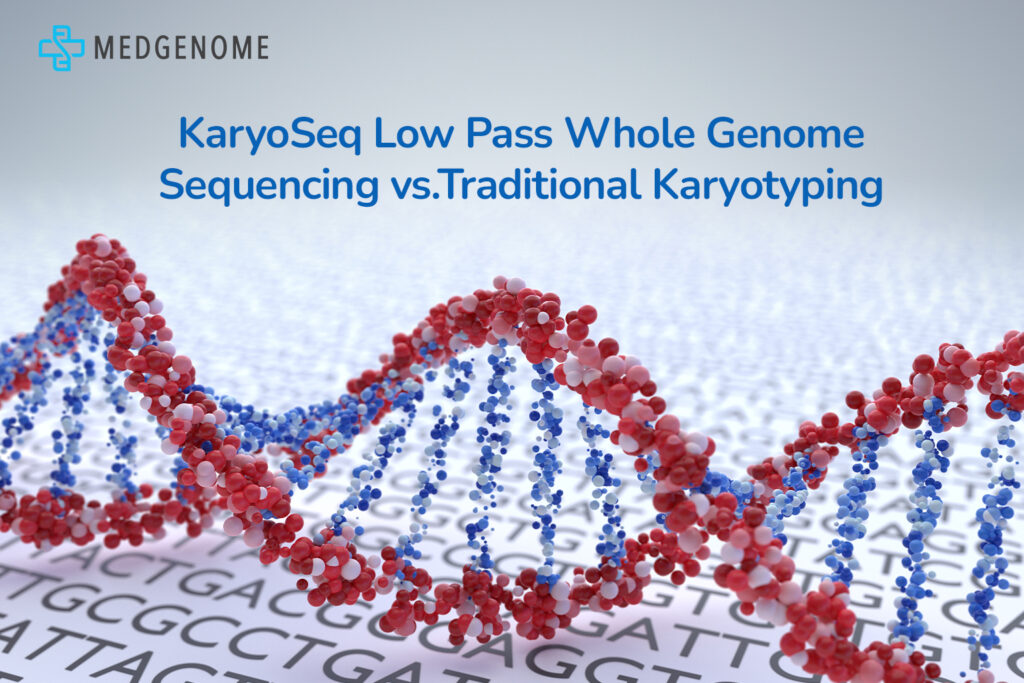In genetic testing, understanding chromosomal abnormalities is crucial for accurate diagnosis and effective management. Traditional karyotyping has long been the standard method for detecting these abnormalities, but emerging technologies like KaryoSeq low-pass whole genome sequencing (WGS) offer new possibilities. Traditional karyotyping, while foundational, can be limited in its scope and resolution.
Each year in India, more than 1.7 million children are born with birth defects, some of which may have genetic causes. This highlights an urgent need for more precise diagnostic tools. But how do these methods compare, and what does this mean for patients seeking precise and timely genetic insights?
What is Traditional Karyotyping?
Traditional karyotyping is a fundamental technique that examines a cell’s number and structure of chromosomes. Imagine chromosomes as the instruction manuals for our bodies, neatly packed into pairs. The karyotype test helps us closely examine these manuals to ensure everything is in order.
Here’s the process: Scientists collect cells, often from blood or amniotic fluid, and make them divide in the lab. They stain the chromosomes to make them visible under a microscope and then arrange them into pairs based on size and shape. This organised display, a karyotype, helps identify any chromosomal disorders, such as extra or missing chromosomes.
What is KaryoSeq Low Pass Whole Genome Sequencing?
KaryoSeq low-pass Whole Genome Sequencing is like giving your genome a quick but insightful scan. Imagine it as a high-tech snapshot that offers a broad overview of your genetic makeup without delving into every detail.
Key Differences Between KaryoSeq and Traditional Karyotyping
Here’s a look at the key differences that set these two methods apart regarding resolution, efficiency, and scope.
Speed and Efficiency
In terms of speed, KaryoSeq has the upper hand over traditional karyotyping. Traditional karyotyping involves several steps, including cell culture, staining, and microscopic analysis, which can be time-consuming and may take weeks to complete. KaryoSeq, with its automated sequencing technology, can deliver results more rapidly, often within a few days. This efficiency is crucial for timely diagnosis and intervention, particularly in urgent clinical scenarios.
Type and Extent of Detectable Abnormalities
KaryoSeq excels in detecting a wider range of genetic abnormalities. While traditional karyotyping spots major chromosomal changes, including those related to Down syndrome and Turner syndrome, KaryoSeq reveals smaller alterations and hidden abnormalities, including tiny copy number variations (CNVs) that might be missed otherwise. This advanced method offers a complete picture, ensuring a thorough and precise diagnosis.
Think of traditional karyotyping as a classic camera with a limited zoom lens. It captures the broad strokes of chromosomal disorders but sometimes misses the finer details. KaryoSeq, however, is like having a high-powered telescope for your genome. It provides a much finer resolution, revealing even the tiny chromosomal changes that traditional methods might overlook. This enhanced sensitivity is crucial for uncovering hidden issues that could go unnoticed.
With KaryoSeq, subtle deletions, duplications, and other small anomalies come into view, offering a more precise and comprehensive picture of your genetic landscape. This enhanced sensitivity is crucial for uncovering hidden issues that could go unnoticed. This advanced method ensures a thorough and accurate diagnosis by providing a complete view of potential abnormalities.
Cost and Accessibility
Traditional karyotype analysis is usually budget-friendly thanks to its long-standing use and established methods. It’s accessible and economical for many. However, KaryoSeq, although pricier upfront, offers richer insights and can reduce the need for additional tests. As this cutting-edge technology becomes more widespread, its cost is expected to drop, making its comprehensive benefits even more accessible.
Practical Considerations for Choosing Between KaryoSeq and Traditional Karyotyping
Choosing between KaryoSeq and traditional karyotyping depends on a few key factors. Traditional karyotyping might suffice if you’re dealing with routine cases where big chromosomal changes are suspected and in cases of parental testing for repeated miscarriages. But for more complex cases or when traditional methods haven’t provided clear answers, KaryoSeq offers a deeper dive into your genetic makeup. Think about the specifics of the condition, how much detail you need, and what testing options are available to make the best choice.
Future Directions and Innovations
Genetic and chromosome testing is on a thrilling journey of progress. Expect exciting upgrades in KaryoSeq technology, which could boost its resolution, reduce costs, and make it more accessible. Imagine combining KaryoSeq with other cutting-edge genomic tools, like whole exome or genome sequencing tests, to unlock even more secrets of our DNA. As research accelerates and technology evolves, both KaryoSeq and traditional karyotyping are poised for remarkable advancements, promising a future where genetic insights are more detailed, efficient, and impactful than ever.
Conclusion
In summary, while traditional karyotyping has been a cornerstone of genetic analysis, KaryoSeq low-pass whole genome sequencing offers significant advantages regarding resolution, sensitivity, and comprehensiveness. As technology advances, KaryoSeq is likely to become an increasingly valuable tool in diagnosing and managing genetic disorders in the future. Choosing the right method depends on the specific clinical context and the level of detail required.
MedGenome provides cutting-edge genetic testing services, including KaryoSeq, to help you get accurate and timely insights into your genetic health. Contact us today to learn more about our advanced testing solutions and how we can assist with your genetic analysis needs.


 Enquire
Now
Enquire
Now